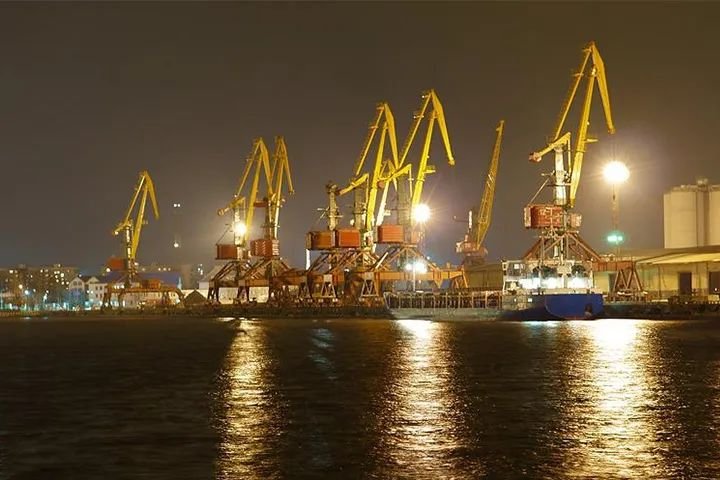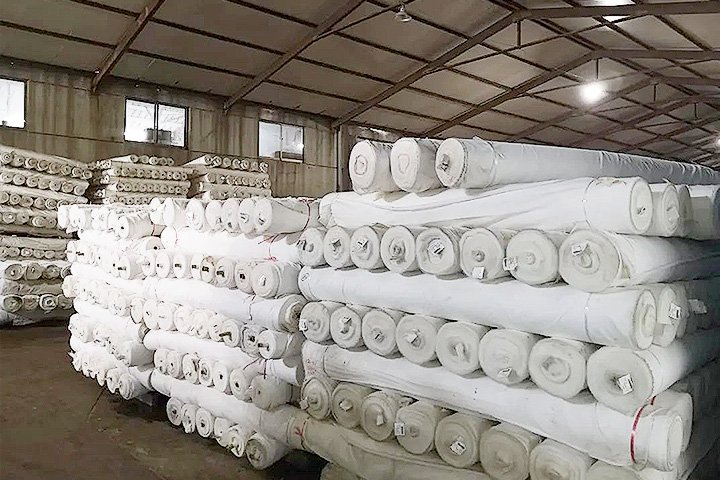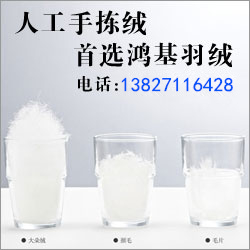Cn-down > Domestic news > News content
2024-08-11 来源:金绒 浏览量:1056
Market Summary
In the 32nd week of 2024 (August 5-11), the market was generally stable, with goose down falling slightly.

With the arrival of the Beginning of Autumn, the temperature across the country will gradually drop from its highest point. At present, a strong cold front has set out from the north, and its important task is to repel the subtropical high pressure and end the extreme high temperature in the south. At the same time, under the influence of the intersection of cold and warm air, a wave of extreme heavy rain began to hit several provinces in the north.
The current price of down and feather remains roughly stable, but the price center of gravity is still slowly moving down, which more or less reflects the supply and demand situation this year. As downstream purchases will enter the peak season at the end of August, many product companies are still on the sidelines. Now without the support of orders, the down and feather raw material transactions can only continue to remain light.
This week, the output of white-feathered commercial ducklings continued to increase slightly, but the industry predicts that the output will begin to decline in mid-August. The recent surge in duckling prices has also reduced the enthusiasm for contract releases, and the decline in duck feather prices has gradually failed to support the operating costs of duck farms.
Good News This Week
From August 1st to August 3rd, the 2024 Pinghu China Garment City August Original Selected Down Jacket Joint Ordering Conference came to a successful conclusion.
At the order fair, merchants displayed various down jackets, and buyers and wholesalers carefully viewed the new down jackets and negotiated orders. It is understood that this order fair brought together 90 high-quality down jacket brands, with as many as 4,500 merchants attending the order fair, and up to 2,000 people at peak times. A total of 1.6 million down jackets were sold, with sales reaching 320 million yuan.

Based on the ordering data, merchants can predict this year's fashion trends in advance and make preparations early. In the past two years, the simplicity and new Chinese style of down jackets have become the hot items and new development routes for many merchants. The cutting-edge design vision is inseparable from the advance grasp of the market, so it is extremely important to take advantage of off-season sales.
This summer, down jackets are selling like hot cakes despite the high temperature of 40℃. Wang, a merchant from Wuhan, said with a smile: I bought a house and a car by selling down jackets. In June, 36% of merchants in Pinghu China Garment City started work, 43% of merchants said that the number of new orders had increased, and 33% of merchants said that downstream sales had increased.
source | 平湖发布
The General Administration of Customs announced on August 7 that in the first seven months, my country's total import and export value of goods trade was 24.83 trillion yuan, a year-on-year increase of 6.2%, in terms of RMB (hereinafter referred to as the same). Among them, exports were 14.26 trillion yuan, an increase of 6.7%; imports were 10.57 trillion yuan, an increase of 5.4%; and the trade surplus was 3.69 trillion yuan, an increase of 10.6%.
In July, the total value of imports and exports was RMB 3.68 trillion, up 6.5% year-on-year. Among them, exports were RMB 2.14 trillion, up 6.5%; imports were RMB 1.54 trillion, up 6.6%. The trade surplus was RMB 601.9 billion.
Lv Daliang, Director of the Statistics and Analysis Department of the General Administration of Customs, said that since the beginning of this year, my country's economic operation has been generally stable and has made progress, and foreign trade has maintained a stable and positive trend. The scale of imports and exports in the first seven months hit a record high for the same period in history. In July, imports and exports increased both year-on-year and month-on-month, and the year-on-year growth rate remained above 5% for four consecutive months.

Experts said that my country's overall export growth rate in July declined slightly year-on-year, but still maintained a relatively fast growth. The slowdown in export growth was mainly due to the decline in export growth to ASEAN and Japan, but the growth rate of exports to the United States and the European Union accelerated.
It is worth noting that the JPMorgan Chase Global Manufacturing PMI index fell to 49.7% in July, ending six consecutive months of expansion, indicating that my country's export growth rate may trend down. Looking ahead to August, exports are expected to continue to grow, but the export growth rate in the second half of the year may show a downward trend.
In addition, from January to July, my country's total exports of textiles and clothing to the world totaled 1,206.82 billion yuan, up 3.7%, of which textile exports totaled 574.53 billion yuan, up 6%; clothing exports totaled 632.29 billion yuan, up 1.6%. In July, textile exports totaled 82.14 billion yuan, up 3% year-on-year; clothing exports totaled 108.55 billion yuan, down 4.6% year-on-year.
source | 金绒采编自海关总署、金融界
According to statistics from the Vietnam Textile and Garment Group (Vinatex), textile and clothing exports reached US$16.52 billion in the first half of 2024, a year-on-year increase of 4.6%; among them, it reached US$8.7 billion in the second quarter of 2024, an increase of 11.2% over the first quarter of 2024.
In the first six months of 2024, the main export markets of the Textile and Apparel Group were the United States, reaching US$7.21 billion, an increase of 3.6%; the European Union reached US$1.95 billion, an increase of 0.8%; Japan reached US$1.87 billion, an increase of 6.8%; South Korea reached US$1.36 billion, an increase of 1.1% over the same period last year.

The increase in orders has led to improved operating performance for some textile and apparel companies. Kwong Lung, a large down jacket OEM manufacturer that has invested in Vietnam, pointed out that based on the current orders on hand, the market demand for outdoor functional clothing has been slowly recovering. The market expects that Kwong Lung's revenue in the second half of the year will grow by double digits compared to the first half of the year.
In addition, the Vietnamese government issued a minimum wage decree in July. The minimum wage in Ho Chi Minh City was raised to 4.96 million VND (equivalent to 197.03 USD), a 5.98% increase. Guangyue, a large down jacket OEM manufacturer, pointed out that the company has completed the follow-up of the salary adjustment and the burden on the company's operations is not heavy.
source | 越南通讯社、工商时报
Bad News This Week
Customs data showed that China's textile and clothing exports in July fell unexpectedly despite a low base, and the negative export growth was mainly dragged down by the decline in clothing exports. Preliminary analysis shows that the main reason for the decline in China's clothing exports is the rapid decline in export prices. In the second quarter, clothing export prices fell by 9.3% overall, and the downward trend continued into the third quarter.
In that month, my country's textile and clothing exports to the world amounted to US$26.8 billion, down 0.5% year-on-year (down 1% in RMB). Among them, textile exports amounted to US$11.54 billion, up 4.0% year-on-year (up 3.5% in RMB); clothing exports amounted to US$15.26 billion, down 3.6% year-on-year (down 4.2% in RMB), a 3 percentage point increase from the previous month.

Since the beginning of this year, market demand in developed countries has remained stable, providing good conditions for the release of my country's textile industry's export competitiveness, and textile and clothing exports have generally achieved growth beyond expectations. However, due to factors such as the delayed interest rate cut in the US dollar and the slowdown in inflation, there is downward pressure on the international market in the second half of the year.
Looking ahead to the third quarter and the future, China's textile and clothing exports are still facing uncertainties such as unstable growth in external demand, intensified geopolitical risks, and increased trade barriers. The complex and severe external situation still brings great uncertainty and risk challenges to China's textile industry's foreign trade.
source | 中国纺织品进出口商会
On August 1, data released by the U.S. Institute for Supply Management (ISM) showed that the U.S. ISM manufacturing index shrank for four consecutive months in July, the 20th time in the past 21 months, and the rate of contraction in July was faster.
In July, the US ISM Manufacturing PMI index fell 1.7 points to 46.8 (50 is the dividing line between prosperity and contraction). In March, the US ISM Manufacturing Index unexpectedly reached 50.3, ending 16 consecutive months of manufacturing contraction, but in the following months, the expansion achieved in a single month was only short-lived.
In terms of important sub-indices, the new order index continued to shrink, recording 47.4, down 1.9 from June; the production index was 45.9, down 2.6 from the previous month; the price index was 52.9, up slightly by 0.8 from June; the employment index fell to 43.4, a sharp drop of 5.9 from June; the new export order index was 49, an improvement of 0.2 from the previous month, but still in the contraction range.

The data have deepened market concerns about a recession in the U.S. Economists pointed out that there was no sign of recovery in the manufacturing industry in July and the growth outlook was very bleak. It is expected that the slowdown in investment by some companies is related to the approaching election, but business confidence in output improvement in a year is still low.
In the July report, 11 of the 18 industries reported a contraction in activity, while five showed an increase in activity. The six major manufacturing industries - machinery, transportation equipment, fabricated metal products, food, beverages and tobacco products, chemical products and computer and electronic products - all contracted, with textiles also performing poorly.
The Apparel, Leather and Related Products (including Down Products) industry reported no changes in new orders, production, employment, supplier deliveries, inventory, customer inventory, raw material prices, backlogs, new export orders, and imports. This suggests that the industry is relatively stable in the short term.
source | ISM
Since some autumn and winter orders were placed in mid-July, the business conditions of enterprises mainly engaged in differentiated yarns have improved, but the new orders are mainly for foreign trade, and there has been no significant improvement in domestic sales orders. Enterprises are operating at full capacity, and product inventories have slightly decreased, but the sustainability remains to be seen. Enterprises are generally pessimistic about the future market.
A textile company in Xuzhou, Jiangsu Province said that in previous years, starting from mid-July, as orders for domestic bedding, home textiles, labor protection products and autumn and winter clothing were gradually placed, cotton yarn production and demand picked up faster, but this year the arrival of orders is expected to be delayed.

The company believes that the new orders in mid-to-late August will be the "barometer" of the entire cotton textile and apparel market in the second half of 2024. Whether domestic demand can be started is the key, and "waiting for the wind to come" is the general mentality of cotton textile companies.
Judging from market feedback, the current textile market is mainly dominated by autumn and winter fabrics. A textile company said that currently orders are mainly small batches, custom-made varieties have improved slightly, and sample analysis has increased.
source | 中储棉信息中心、绸都网
News Situation
This week's news is mixed with both positive and negative news.
Although my country's overall foreign trade has maintained growth, the export growth of textiles and clothing has slowed down, especially clothing exports, which fell by 4.6% year-on-year in July. The overall decline in clothing export prices has led to a decline in export volume, and the export situation in the third quarter and in the future is still full of uncertainty.
The rapid contraction of the US ISM manufacturing index in July has intensified market concerns about a US recession. This may further affect global demand for down and its products, especially as the US is one of the main export markets for Chinese down products, and its economic conditions will directly affect export orders.
The postponement of domestic sales orders reflects the weakness of the domestic market, and companies are cautious about future market prospects. The order situation in August will become a barometer of the market in the second half of the year, and whether domestic demand can be stimulated will be the key.
 热门排行
中国三大羽绒生产基地之—广东吴川
全球最奢侈羽绒服排行
一件羽绒服需要多少只鸭子的羽绒?
飞丝是什么?能代替羽绒?别被骗了,三种方法让你告别假羽绒服!
2017羽绒原料价格一路上涨,究竟为何?
你的羽绒服为什么钻绒?涨知识了
羽绒被的价格一般是多少 通过成本看羽绒被价格
中国羽绒服四大品牌调查:到底谁才是最强王者?
羽绒金网:羽毛、羽绒、毛绒计价
《羽绒羽毛》、《羽绒羽毛检验方法》新版标准发布,2017年7月1日实施
热门排行
中国三大羽绒生产基地之—广东吴川
全球最奢侈羽绒服排行
一件羽绒服需要多少只鸭子的羽绒?
飞丝是什么?能代替羽绒?别被骗了,三种方法让你告别假羽绒服!
2017羽绒原料价格一路上涨,究竟为何?
你的羽绒服为什么钻绒?涨知识了
羽绒被的价格一般是多少 通过成本看羽绒被价格
中国羽绒服四大品牌调查:到底谁才是最强王者?
羽绒金网:羽毛、羽绒、毛绒计价
《羽绒羽毛》、《羽绒羽毛检验方法》新版标准发布,2017年7月1日实施
 推荐阅读
“吴川力量”助中国羽绒接轨世界
中国三大羽绒生产基地之—广东吴川
中羽协第二期新国标培训班 在“羽绒之乡”广东吴川成功举办
羽绒之乡:贵港桥圩镇将打造旅游休闲特色小镇
广西贵港桥圩镇:打造中国羽绒休闲旅游特色小镇
羽绒金网:羽毛、羽绒、毛绒计价
羽绒别急着收 中央气象台发布寒潮蓝色预警 部分地区降温超12℃
上海消保委检测 千元鹅绒被用鸭毛绒填充
冻哭丨降温10℃!鸡年首个寒潮预警来袭,你准备好了吗?
传统羽绒产业如何实现转型升级?四川玉泉镇产业集群发展
推荐阅读
“吴川力量”助中国羽绒接轨世界
中国三大羽绒生产基地之—广东吴川
中羽协第二期新国标培训班 在“羽绒之乡”广东吴川成功举办
羽绒之乡:贵港桥圩镇将打造旅游休闲特色小镇
广西贵港桥圩镇:打造中国羽绒休闲旅游特色小镇
羽绒金网:羽毛、羽绒、毛绒计价
羽绒别急着收 中央气象台发布寒潮蓝色预警 部分地区降温超12℃
上海消保委检测 千元鹅绒被用鸭毛绒填充
冻哭丨降温10℃!鸡年首个寒潮预警来袭,你准备好了吗?
传统羽绒产业如何实现转型升级?四川玉泉镇产业集群发展